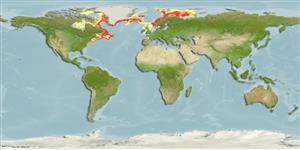Classification / Names
Common names from other countries
Main reference
Size / Weight / Age
Max length : 110 cm TL male/unsexed; (Ref. 35388); max. reported age: 25 years (Ref. 1371)
Length at first maturity
Lm 54.3 range ? - ? cm
Environment
Marine; benthopelagic; non-migratory; depth range 100 - 1000 m (Ref. 1371), usually 300 - 500 m (Ref. 54573)
Climate / Range
Temperate; ? - 4°C (Ref. 1371), preferred 2°C (Ref. 107945); 82°N - 37°N, 95°W - 61°E (Ref. 54573)
Distribution
North Atlantic: Norfolk Canyon and George Bank north to Labrador, Davis Strait, eastern and western Greenland, Iceland, and from the Irish Atlantic slope north to Faeroe Islands, Norwegian coast, to Spitzbergen, and to the Barents Sea.
Countries | FAO areas | Ecosystems | Occurrences | Introductions
Short description
Dorsal
spines
(total): 0;
Anal
spines: 0. Snout short, rather strongly pointed; mouth small, inferior. Underside of head almost entirely naked. Pyloric caeca about 19 or 20. Overall color is gray, darker ventrally on trunk; anal fin dark-edged, first dorsal and pectoral fins dusky (Ref. 1371). Front end of dorsal fin spine is serrated (Ref. 35388).
IUCN Red List Status (Ref. 115185)
Threat to humans
Harmless
Human uses
Fisheries: commercial
More information
ReferencesAquacultureAquaculture profileStrainsGeneticsAllele frequenciesHeritabilityDiseasesProcessingMass conversion
Tools
Special reports
Download XML
Internet sources
Estimates of some properties based on models
Phylogenetic diversity index
PD50 = 0.5312 many relatives (e.g. carps) 0.5 - 2.0 few relatives (e.g. lungfishes)
Trophic Level
3.6 ±0.53 se; Based on food items.
Resilience
Very Low, minimum population doubling time more than 14 years (tm=15; tmax=25; Fec=25,000)
Vulnerability
High to very high vulnerability (75 of 100)
Price category
